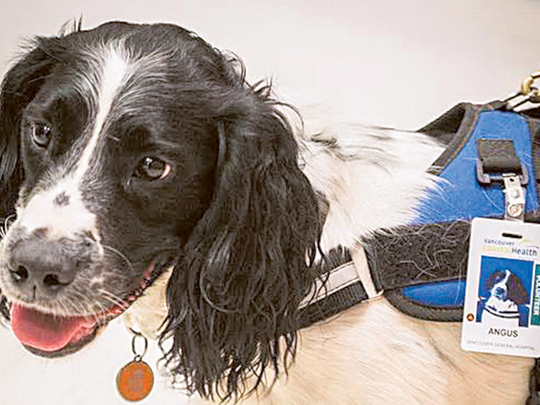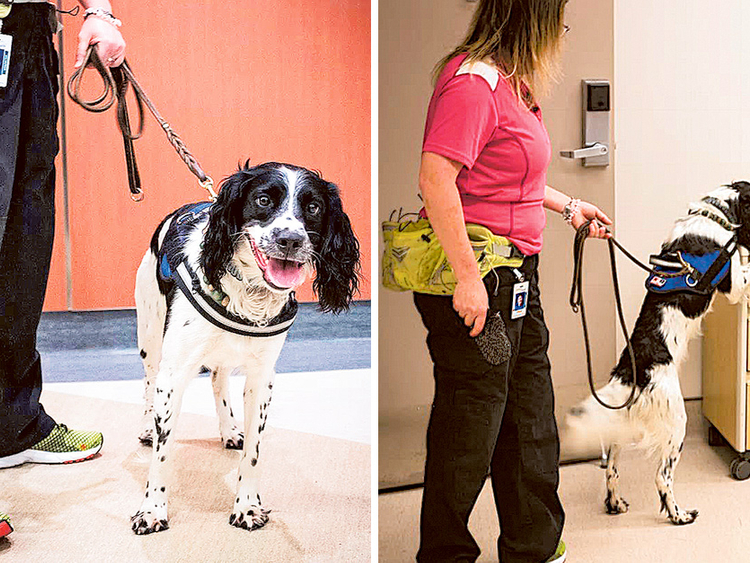
VANCOUVER, CANADA: Hospital ID badge dangling from his neck, Angus considered the empty bed in front of him. After a few strong sniffs, he moved on.
Nearing the next bed, his floppy ears perked up before he stopped dead in his tracks, tapping his paw and eyeing his handler expectantly.
The two-year-old English springer spaniel is believed to be the only canine hospital employee in the world trained to sniff out the notorious superbug Clostridium difficile, or C difficile.
The seeds of Angus’ unlikely career were planted three years ago, after Teresa Zurberg, a Vancouver resident, suffered a C difficile infection. Her bout with the bacteria — which attacks people whose immune systems have been weakened by antibiotics — left her in the hospital for five days and she lost 20 pounds.
“It was awful. I almost died,” Zurberg said.
Her husband, Markus, a nurse who works in patient safety and quality care, stumbled across an article on a beagle in the Netherlands who had been specially trained to check patients for C difficile.
Could Zurberg — a canine handler who trains bomb — and drug-detecting dogs — do the same thing in Vancouver? he wondered. “I told him, ‘If it’s got a smell, I can teach a dog to find it,’” Zurberg said. Their new beagle pup might be perfect for the job, she suggested.
The pair approached Vancouver Coastal Health, the health authority that oversees the city’s general hospital — and were surprised by the enthusiastic reaction they received. “I was expecting them to laugh at us but they were like: ‘Hey, that’s really cool.’”
Working with the health authority, Zurberg and Angus became part of a one-of-a-kind pilot programme. The hope, said Nancy Desrosiers of Vancouver Coastal Health, was to find an innovative approach to address what has become a global concern.
“It really is one of those vicious cycles,” she said, pointing to a steadily rising number of infections that result in longer hospital stays and increase the likelihood of further infections. “In Canada, 64 per cent of all of our C difficile cases are hospital-acquired.”
Unlike the patient-sniffing beagle in the Netherlands — who is now retired — Angus, it was decided, would focus exclusively on searching for C difficile in the hospital environment.
Hospitals normally use ultraviolet light to find the bacteria, but Angus can move much more quickly and efficiently through rooms. Once he detects the bacteria, the area is cleaned with a robot that uses ultraviolet light to disinfect 99.9 per cent of the C difficile spores.
The decision to have him work on environments rather than patients minimised the chances of Angus triggering patients who may have allergies or sensitivities to dogs.
With the dog’s role in the hospital now clearly laid out, Zurberg began training Angus, mimicking the techniques used to train dogs to detect bombs or drugs.
“All of the detection work for the dogs, it’s just a game. To them, it’s just a way to get what they really want, which is their toy or their food, depending on what they’re rewarded with.”
As she taught him to associate the scent with a food reward, researchers from the hospital kept her stocked with a steady supply of the scent of C difficile — isolated from the bug — on cotton swabs.
The training took about 10 months. After passing a series of detection tests in a local nursing college with mock patient wards, Angus was brought into the hospital this summer.
Easily excitable when he’s not focused on work, Angus is accompanied by Zurberg at all times during the four days a week he spends at the hospital.
“It’s a very multi-ethnic health authority and I have to be really conscious of who’s around me and what issues they may have with dogs,” she said. “That’s part of the reason we chose a floppy-eared dog as opposed to a pointy-eared dog, because he’s not so intimidating-looking.”
Like any other member of the hospital staff, Angus faces a slight risk that he could be infected by C difficile. “He’s young and he’s not autoimmune compromised, so his risks are extremely low,” Zurberg said. His health is carefully monitored through regular veterinarian visits, she added.
His stint at the hospital has attracted global attention, and health authorities from Finland to Chile have contacted Zurberg with questions about replicating the idea. The aim, said Zurberg, is to develop a program that would train other dogs to sniff out C difficile and make them available to hospitals around the world.
Zurberg’s voice raises with excitement as she contemplates the possibility that Angus might hold the key to regaining control over a superbug that has affected so many people around the world.
“So many people come up to me and say: ‘My dad died of C diff,’ or ‘This person in my family has C diff,’ and they thank me for what we’re doing,” she said. “It opens the doors to other possibilities — what else can we have a dog detect? We’re only really limited by our imagination.”
Deadly bacteria lurks in hospitals and attacks the most vulnerable
What is Clostridium difficile?
C difficile is a virulent new strain of bacteria linked to three times as many deaths as the notorious hospital superbug MRSA. It is a common bacteria carried harmlessly in the gut of half of all children aged under two, and many adults. Unlike MRSA, C difficile is not resistant to antibiotics and not officially recognised as a superbug.
How serious is it?
C difficile symptoms range from mild diarrhoea to severe illness with ulceration and bleeding from the colon. It can lead to perforation of the intestine, causing peritonitis — a serious infection or inflammation of part of the thin membrane that covers the intestinal tract and abdominal organs.
Who is most at risk?
The infection can be life-threatening in older patients — more than 80 per cent of cases are reported in people over 65.
How you get C. difficile
C. difficile bacteria are found in the digestive system of about 1 in every 30 healthy adults. The bacteria often live harmlessly because the other bacteria normally found in the bowel keep it under control. However, some antibiotics can interfere with the balance of bacteria in the bowel, which can cause the C. difficile bacteria to multiply and produce toxins that make the person ill. When this happens, C. difficile can spread easily to other people because the bacteria are passed out of the body in the person’s diarrhoea. Once out of the body, the bacteria turn into resistant cells called spores. These can survive for long periods on hands, surfaces (such as toilets), objects and clothing unless they’re thoroughly cleaned, and can infect someone else if they get into their mouth. Someone with a C. difficile infection is generally considered to be infectious until at least 48 hours after their symptoms have cleared up.
How is the bacterium transmitted?
It produces hardy spores, which are carried in a sufferer’s liquid faeces, and these can contaminate the area around an infected patient’s bed. Poor hygiene can lead to a serious outbreak. The spores are not destroyed by the alcohol wipes now used by doctors and nurses to prevent the spread of most bacteria. Surfaces must be cleaned with bleach, and hands thoroughly washed with soap and water.













